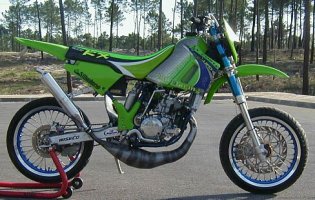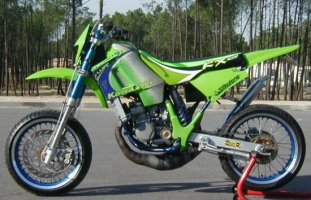jaguar
~SPONSOR~
From a former post by someone in Europe whose kin was a race engine builder:
This is my translation from Portugese.
50hp KDX200
Piston: Wiseco for KDX 200, with std diameter of 66mm. It was also necessary to sandpaper the piston in zones of potential friction due to the different temperatures that the same is submitted to, and for giving the intended conical shape relative to it and the cylinder.
Nickasil cylinder was redone with a steel sleeve.
Degrees of transfer intake windows opeining- 136º (ports 3mm higher than stock)
Degrees of exhaust windows opening - 198º (ports 1mm higher than stock)
Displacement of the engine is 198.3cm3 (value exact).
The volume of the combustion chamber with piston at TDC is 16.5 cubed centimeters.
The compression ratio using the European traditional formula is approximately 13.5:1; the Japanese formula is presented as more correct, but we did not make this measurement.
Spark plug number 10 (NGK B10 EG) due to already high compression ratio.
We kept the original 3 KIPS exhaust valves, going off 2,500 RPM earlier (at 3500 instead of 6000).
Carbon BOYESEN Reeds for KDX 200 with 4 petals (2+2) were used.
Carburetor is MIKUNI TM 41mm (with guillotine throttle valve), without Power Jet. Without air filter to allow the biggest possible air flow, correcting for this with different jets. What it is intended is the biggest possible volume of air-fuel flow to be vaporized for the combustion chamber, as far as the reeds allow. Remember that certain 125 GP bikes also use carburetors of 41mm. A main concept is that the area grows exponentially, that is that a carburetor of 24mm has more than double the area of one of 12mm (using the factor “pi” in the formula of the area of the circle).
Seletra rotor without light, now with CDI incorporated for Yamaha DT 50/TZR 50, adapted in the tip of chamber with plate rectified for correct fitting. (notice that the magnetic flywheel of this system is slightly smaller and lighter than existing magnetic flywheels in 125 and 250 motocross bikes without lights).
Engine ignition - combustion at high revolutions at 1mm before the PMS of the piston - refining of the joint flywheel-plate.
Connecting rod from a KTM 200, that it has a center length (bearing center-to-center) of 118 mm (that corresponds to 2mm more that of the KDX cylinder at 116 mm). This alteration, having in account that original KDX connecting rod has 109 mm center-to-center, brought 2 advantages and 1 disadvantage: a lesser inclination makes possible a bigger angle of rod to cylinder, while it increases the capacity and rapidity to make high rpm’s and bring less friction so the piston-cylinder has longer durability; As a disadvantage, it diminishes the value of the pre-compression (crankcase pressure), a factor important for the rapidity/impulse of the mixture of the low-end chamber in order for the same to be compressed in the combustion chamber and to ignite (to enhance the compression we had to change the transfer timing). The difference of lengths between the old connecting rod and the new, compels the use of an aluminum spacer at the base of the cylinder with a corresponding height for this difference.
Upper connecting rod bearings from racing KTM 200 (it comes in the flywheel kit), with good construction.
Lower connecting rod bearings from racing racing KTM 200 (it comes in the flywheel kit), with good construction.
Clutch with stronger special springs, to not allow the plates to slip. It keeps lateral weight of the assembly to not be noisey and not to vibrate, to compensate for the movement of the piston - > Counterbalance the motor.
Battery from 900 Honda CBR FireBlade with wire linking and terminals for lighting. Battery box made manually and placed underneath the seat. Its duration with high light on is 7.2 hours. Formula: (max Battery Current x Voltage Battery)/Consumption of the Electric Circuit = (1A x 12v)/20 = .6 hours
Aluminum in the cylinder base to regularize the loss of Pre-Compression (crankcase pressure).
Hand made racing exhaust pipe based on mathematical formulas, with head pipe 44mm dia, maximum diameter in the "belly" of pipe 130mm, and pipe for the exit tip with diameter of 25mm.
Adaptation of a radiator (Gilera track 125), pipes and retainers, remaining itself 1 of the radiators that came originally in the motion (1 of the 2 that possessed greater amount of fluid), for form if to get better refrigeration of the engine with 2 radiators.
Oil mixture direct in the gas tank is between 2% (50/1) to 3% (33/1), depending on the given use: In great effort - > 3%. Little effort 2.5%. Daily normal use - > 2%. Used oil currently: MOTOREX GP 100% Synthetic. Oil used for eventual race: ELF HTX Karting/Castrol A747. Oils used previously: Synthetic IPONE KARTING 100% Synthetic Penzoil
100% Creation and Theoretical formularization of the Project, confirmations, choice and acquisition of the correct materials for the preparation in charge of Peter and Ricardo Baeta. Preparation of Engine effected for LuFo (Fonseca Luis)
Engine Performance:
Assay of power - > to effect 11,400rpm maximum.
RPM to which the power crosses binary - > ~9,400rpm
Power at crank - > ~57 horses
Power at rear wheel - > ~52 horses
Weight/Power ratio = .57 cv/kg
Linear speed of the piston: 22 m/s.
Number of explosions at top rpm: (11,400rpm/60) = 190 per second
Sprockets: 18 / 47
This KDX 200 reached a real maximum top speed of 187 km/hr in 6th gear (118mph)
This is my translation from Portugese.
50hp KDX200
Piston: Wiseco for KDX 200, with std diameter of 66mm. It was also necessary to sandpaper the piston in zones of potential friction due to the different temperatures that the same is submitted to, and for giving the intended conical shape relative to it and the cylinder.
Nickasil cylinder was redone with a steel sleeve.
Degrees of transfer intake windows opeining- 136º (ports 3mm higher than stock)
Degrees of exhaust windows opening - 198º (ports 1mm higher than stock)
Displacement of the engine is 198.3cm3 (value exact).
The volume of the combustion chamber with piston at TDC is 16.5 cubed centimeters.
The compression ratio using the European traditional formula is approximately 13.5:1; the Japanese formula is presented as more correct, but we did not make this measurement.
Spark plug number 10 (NGK B10 EG) due to already high compression ratio.
We kept the original 3 KIPS exhaust valves, going off 2,500 RPM earlier (at 3500 instead of 6000).
Carbon BOYESEN Reeds for KDX 200 with 4 petals (2+2) were used.
Carburetor is MIKUNI TM 41mm (with guillotine throttle valve), without Power Jet. Without air filter to allow the biggest possible air flow, correcting for this with different jets. What it is intended is the biggest possible volume of air-fuel flow to be vaporized for the combustion chamber, as far as the reeds allow. Remember that certain 125 GP bikes also use carburetors of 41mm. A main concept is that the area grows exponentially, that is that a carburetor of 24mm has more than double the area of one of 12mm (using the factor “pi” in the formula of the area of the circle).
Seletra rotor without light, now with CDI incorporated for Yamaha DT 50/TZR 50, adapted in the tip of chamber with plate rectified for correct fitting. (notice that the magnetic flywheel of this system is slightly smaller and lighter than existing magnetic flywheels in 125 and 250 motocross bikes without lights).
Engine ignition - combustion at high revolutions at 1mm before the PMS of the piston - refining of the joint flywheel-plate.
Connecting rod from a KTM 200, that it has a center length (bearing center-to-center) of 118 mm (that corresponds to 2mm more that of the KDX cylinder at 116 mm). This alteration, having in account that original KDX connecting rod has 109 mm center-to-center, brought 2 advantages and 1 disadvantage: a lesser inclination makes possible a bigger angle of rod to cylinder, while it increases the capacity and rapidity to make high rpm’s and bring less friction so the piston-cylinder has longer durability; As a disadvantage, it diminishes the value of the pre-compression (crankcase pressure), a factor important for the rapidity/impulse of the mixture of the low-end chamber in order for the same to be compressed in the combustion chamber and to ignite (to enhance the compression we had to change the transfer timing). The difference of lengths between the old connecting rod and the new, compels the use of an aluminum spacer at the base of the cylinder with a corresponding height for this difference.
Upper connecting rod bearings from racing KTM 200 (it comes in the flywheel kit), with good construction.
Lower connecting rod bearings from racing racing KTM 200 (it comes in the flywheel kit), with good construction.
Clutch with stronger special springs, to not allow the plates to slip. It keeps lateral weight of the assembly to not be noisey and not to vibrate, to compensate for the movement of the piston - > Counterbalance the motor.
Battery from 900 Honda CBR FireBlade with wire linking and terminals for lighting. Battery box made manually and placed underneath the seat. Its duration with high light on is 7.2 hours. Formula: (max Battery Current x Voltage Battery)/Consumption of the Electric Circuit = (1A x 12v)/20 = .6 hours
Aluminum in the cylinder base to regularize the loss of Pre-Compression (crankcase pressure).
Hand made racing exhaust pipe based on mathematical formulas, with head pipe 44mm dia, maximum diameter in the "belly" of pipe 130mm, and pipe for the exit tip with diameter of 25mm.
Adaptation of a radiator (Gilera track 125), pipes and retainers, remaining itself 1 of the radiators that came originally in the motion (1 of the 2 that possessed greater amount of fluid), for form if to get better refrigeration of the engine with 2 radiators.
Oil mixture direct in the gas tank is between 2% (50/1) to 3% (33/1), depending on the given use: In great effort - > 3%. Little effort 2.5%. Daily normal use - > 2%. Used oil currently: MOTOREX GP 100% Synthetic. Oil used for eventual race: ELF HTX Karting/Castrol A747. Oils used previously: Synthetic IPONE KARTING 100% Synthetic Penzoil
100% Creation and Theoretical formularization of the Project, confirmations, choice and acquisition of the correct materials for the preparation in charge of Peter and Ricardo Baeta. Preparation of Engine effected for LuFo (Fonseca Luis)
Engine Performance:
Assay of power - > to effect 11,400rpm maximum.
RPM to which the power crosses binary - > ~9,400rpm
Power at crank - > ~57 horses
Power at rear wheel - > ~52 horses
Weight/Power ratio = .57 cv/kg
Linear speed of the piston: 22 m/s.
Number of explosions at top rpm: (11,400rpm/60) = 190 per second
Sprockets: 18 / 47
This KDX 200 reached a real maximum top speed of 187 km/hr in 6th gear (118mph)
Last edited:

